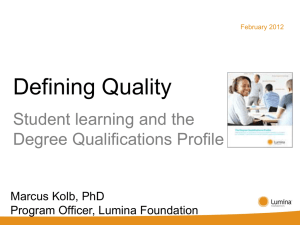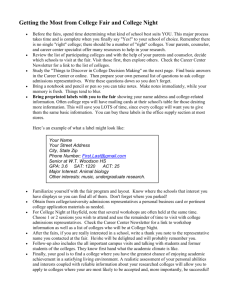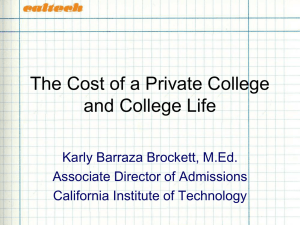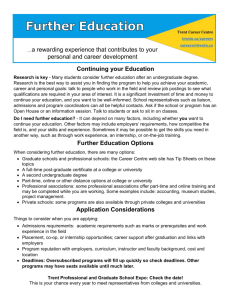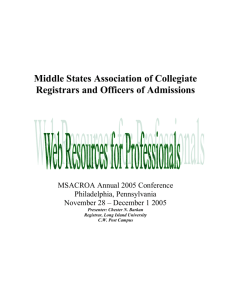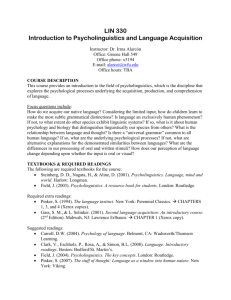Jill Samopol Samopol 1 Mrs. Brown English 9 Honors 20 December
advertisement
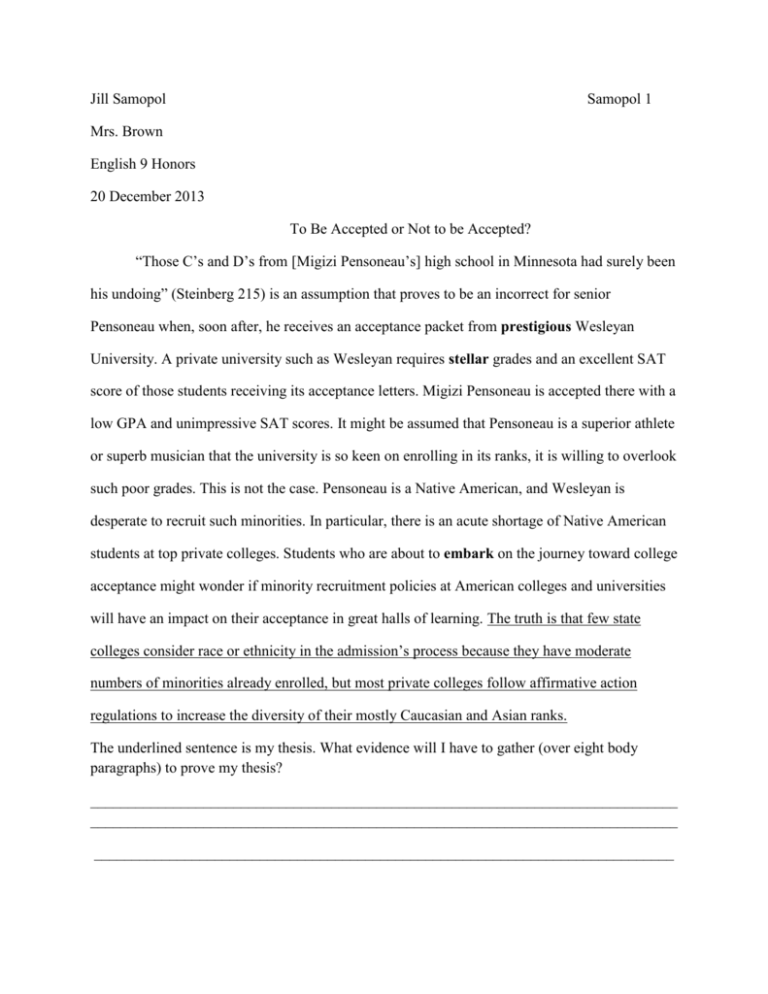
Jill Samopol Samopol 1 Mrs. Brown English 9 Honors 20 December 2013 To Be Accepted or Not to be Accepted? “Those C’s and D’s from [Migizi Pensoneau’s] high school in Minnesota had surely been his undoing” (Steinberg 215) is an assumption that proves to be an incorrect for senior Pensoneau when, soon after, he receives an acceptance packet from prestigious Wesleyan University. A private university such as Wesleyan requires stellar grades and an excellent SAT score of those students receiving its acceptance letters. Migizi Pensoneau is accepted there with a low GPA and unimpressive SAT scores. It might be assumed that Pensoneau is a superior athlete or superb musician that the university is so keen on enrolling in its ranks, it is willing to overlook such poor grades. This is not the case. Pensoneau is a Native American, and Wesleyan is desperate to recruit such minorities. In particular, there is an acute shortage of Native American students at top private colleges. Students who are about to embark on the journey toward college acceptance might wonder if minority recruitment policies at American colleges and universities will have an impact on their acceptance in great halls of learning. The truth is that few state colleges consider race or ethnicity in the admission’s process because they have moderate numbers of minorities already enrolled, but most private colleges follow affirmative action regulations to increase the diversity of their mostly Caucasian and Asian ranks. The underlined sentence is my thesis. What evidence will I have to gather (over eight body paragraphs) to prove my thesis? ______________________________________________________________________________ ______________________________________________________________________________ _____________________________________________________________________________ ROUGH DRAFT OUTLINE 1. Topic sentence 1 Most state or public universities, especially California state universities, rarely consider race in their application process because of a Supreme Court ruling. a. “Regents of the University of California v. Bakke…in 2003 established that race had an appropriate but limited role in the admissions policies of public universities” (“Fisher v. University of Texas” 1). Supreme Court basically said race should NOT be considered. b. “There is a compelling evidence in the educational benefits of diversity to justify racial preferences in university admissions” (“Fisher v. University of Texas” 4). Court still felt that race should not be a major factor in admissions, but agreed that universities such as Texas did need more diversity. 2. Topic sentence 2 The Supreme Court did not destroy affirmative action, but its members acknowledged that considering race in admissions must be closely monitored, leaving a rather ambiguous situation for admissions officers at state and public colleges. a. Fisher said “I’m confident that UT will not be able to use race in the future” (Psencik 2). b. “Defenders of affirmative action say that since the court did not reverse current policies, the odds are in their favor” (Psencik 1). 3. Topic sentence 3 State universities are rarely allowed to consider race in admissions; however, there are still some remaining biases (shows that topic is not as clear cut as my thesis suggests). a. “On-campus organizations are segregated by race” (Bratu 1). b. “Some all-white sororities had blocked chapters from adding two black students as new members” (Bratu 1). 4. Topic sentence 4 Private Wesleyan University has made every effort to increase student diversity in recent years; sometimes to the detriment of those it hoped to promote. (NEED TO ADD THIS TO THESIS?) a. “There were so many people from so many different backgrounds at Wesleyan that Mig didn’t feel like an outsider” (Steinberg 274). b. “He just lacked the desire. Because of his grades, Mig would have to leave Wesleyan” (Steinberg 274). 5. Topic sentence 5 With all the efforts of private universities to increase diversity, the status quo of Caucasian and Asian student proliferation continues. a. “White students [are] five times as likely as black students to enroll in a highly selective college” (Reardon 1). b. “Tiffany was vice-president of the Asian Pride Club…they lived in an affluent area” (Steinberg 158-9). 6. Topic sentence 6 One admissions policy that has halted diversity progress at both public and private colleges is their adherence to the “top ten percent rule.” a. “Such policies are unlikely to increase the proportion of black and Hispanic students enrolled in highly selective colleges” (Reardon 2). b. “Low-income students…[are] found to be dramatically underrepresented in highly selective institutions” (Reardon 1). (WHY WILL EITHER THIS QUOTE OR QUOTE C NOT BOTH WORK?) c. “Only 14 percent of students come from the lower 50 percent of families by income” (Perez-Pena 1). 7. Topic sentence 7 Brown University is another private institution which has invested much to promote diversity. a. “Allocated an additional $200,000…for enhanced…outreach to students from diverse backgrounds” (“Plan for Academic Enrichment” 1). b. “More than 35% of the Class of 2014 are minority students” (“Plan for Academic Enrichment” 2). 8. Topic sentence 8 California State University Long Beach represents a state college which, although it may not admit based upon race, aggressively promotes the recruitment of minorities. (DO I NEED TO MODIFY MY THESIS FOR THIS?) a. “A U.S. citizen, national or permanent resident alien” (Katayama 2). b. “With the goal of increasing the number of well-trained students from underrepresented groups” (Katayama 1). Samopol 5 Works Cited Bratu, Becky. “University of Alabama President Pushes Sororities to End Segregation.” U.S. News.18 Sept. 2013. Web. “Fisher v. University of Texas.” Wikipedia.org. 6 Nov. 2013. Web. Katayama, Mark. “Minority Access to Research Careers.” California State University Long Beach. csulb.edu. 6 Nov. 2013. Web. Perez-Pena, Richard. “Efforts to recruit poor Students Lag at Some Elite Colleges.” The New York Times. 30 July 2013. nytimes.com. 6 Nov. 2013. Web. “Plan for Academic Enrichment.’ Brown University. Sept. 2011. brown.edu. 6 Nov. 2013. Web. Psencik, Katey. “Both Sides Claim Victory in Fisher v. UT.” USA Today. 25 June 2013 usatodayeducate.com. 6 Nov. 2013. Web. Reardon, Sean. “Minority Enrollment: Black and Hispanic Students Underrepresented at Highly Selective Colleges.” Huffington Post.7 July 2012. Huffingtonpost.com. 6 Nov. 2013. Web. Steinberg, Jacques. The Gatekeepers. New York: Penguin Books, 2003. Print. What rules appear to be in play on Works Cited pages? ______________________________________________________________________________ ______________________________________________________________________________ ______________________________________________________________________________ ______________________________________________________________________________ ______________________________________________________________________________ ______________________________________________________________________________ ______________________________________________________________________________ ______________________________________________________________________________ ______________________________________________________________________________ ______________________________________________________________________________

